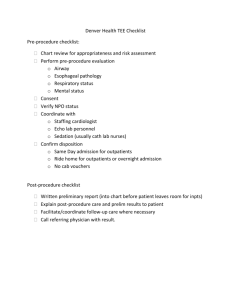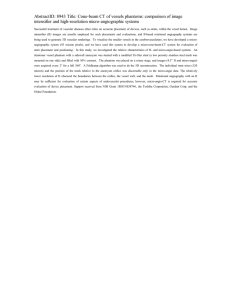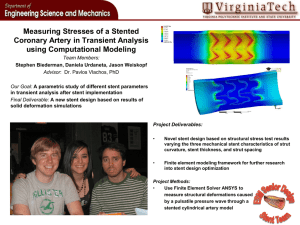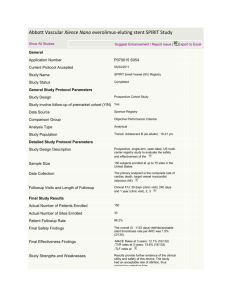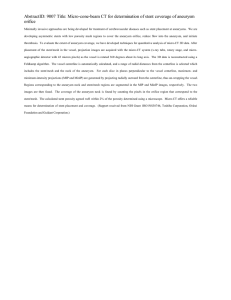Platinum Trial Angiographic Analysis_Popma
advertisement
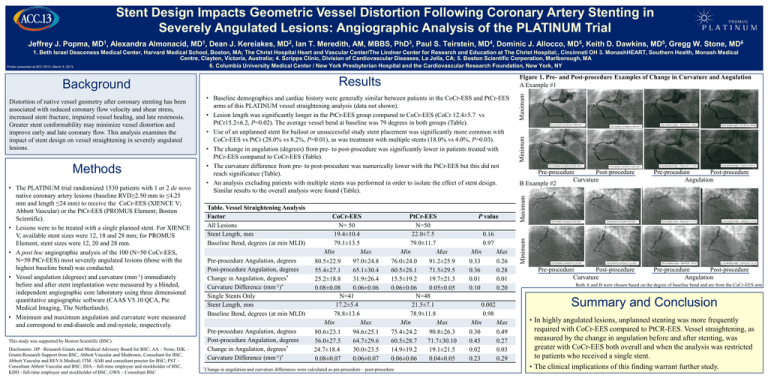
Stent Design Impacts Geometric Vessel Distortion Following Coronary Artery Stenting in Severely Angulated Lesions: Angiographic Analysis of the PLATINUM Trial Jeffrey J. Popma, MD1, Alexandra Almonacid, MD1, Dean J. Kereiakes, MD2, Ian T. Meredith, AM, MBBS, PhD3, Paul S. Teirstein, MD4, Dominic J. Allocco, MD5, Keith D. Dawkins, MD5, Gregg W. Stone, MD6 1. Beth Israel Deaconess Medical Center, Harvard Medical School, Boston, MA; The Christ Hospital Heart and Vascular Center/The Lindner Center for Research and Education at The Christ Hospital;, Cincinnati OH 3. MonashHEART, Southern Health, Monash Medical Centre, Clayton, Victoria, Australia; 4. Scripps Clinic, Division of Cardiovascular Diseases, La Jolla, CA; 5. Boston Scientific Corporation, Marlborough, MA 6. Columbia University Medical Center / New York Presbyterian Hospital and the Cardiovascular Research Foundation, New York, NY Poster presented at ACC 2013, March 9, 2013. • The PLATINUM trial randomized 1530 patients with 1 or 2 de novo native coronary artery lesions (baseline RVD≥2.50 mm to ≤4.25 mm and length ≤24 mm) to receive the CoCr-EES (XIENCE V; Abbott Vascular) or the PtCr-EES (PROMUS Element; Boston Scientific). • Lesions were to be treated with a single planned stent. For XIENCE V, available stent sizes were 12, 18 and 28 mm; for PROMUS Element, stent sizes were 12, 20 and 28 mm. • A post hoc angiographic analysis of the 100 (N=50 CoCr-EES, N=50 PtCr-EES) most severely angulated lesions (those with the highest baseline bend) was conducted. • Vessel angulation (degrees) and curvature (mm-1) immediately before and after stent implantation were measured by a blinded, independent angiographic core laboratory using three dimensional quantitative angiographic software (CAAS V5.10 QCA, Pie Medical Imaging, The Netherlands). • Minimum and maximum angulation and curvature were measured and correspond to end-diastole and end-systole, respectively. This study was supported by Boston Scientific (BSC). Disclosures: JJP –Research Grants and Medical Advisory Board for BSC; AA – None; DJK – Grants/Research Support from BSC, Abbott Vascular and Medtronic, Consultant for BSC, Abbott Vascular and REVA Medical; ITM –SAB and consultant proctor for BSC; PST – Consultant Abbott Vascular and BSC; DJA – full-time employee and stockholder of BSC, KDD - full-time employee and stockholder of BSC, GWS – Consultant BSC Table. Vessel Straightening Analysis Factor All Lesions Stent Length, mm Baseline Bend, degrees (at min MLD) Pre-procedure Angulation, degrees Post-procedure Angulation, degrees Change in Angulation, degrees* Curvature Difference (mm-1)* Single Stents Only Stent Length, mm Baseline Bend, degrees (at min MLD) Pre-procedure Angulation, degrees Post-procedure Angulation, degrees Change in Angulation, degrees* Curvature Difference (mm-1)* *Change CoCr-EES N= 50 19.4±10.4 79.1±13.5 Min Max 80.5±22.9 97.0±24.8 55.4±27.1 65.1±30.4 25.2±18.8 31.9±26.4 0.08±0.08 0.06±0.06 N=41 17.2±5.4 78.8±13.6 Min Max 80.6±23.1 94.6±25.1 56.0±27.5 64.7±29.6 24.7±18.4 30.0±23.5 0.08±0.07 0.06±0.07 PtCr-EES N=50 22.0±7.5 79.0±11.7 Min Max 76.0±24.0 91.2±25.9 60.5±28.1 71.5±29.5 15.5±19.2 19.7±21.3 0.06±0.06 0.05±0.05 N=48 21.5±7.1 78.9±11.8 Min Max 75.4±24.2 90.8±26.3 60.5±28.7 71.7±30.10 14.9±19.2 19.1±21.5 0.06±0.06 0.04±0.05 in angulation and curvature differences were calculated as pre-procedure – post-procedure P value 0.16 0.97 Min 0.33 0.36 0.01 0.10 Max 0.26 0.28 0.01 0.20 0.002 0.98 Min Max 0.30 0.49 0.45 0.27 0.02 0.03 0.23 0.29 Maximum Minimum Pre-procedure Post-procedure Curvature B Example #2 Pre-procedure Post-procedure Angulation Maximum Methods • Baseline demographics and cardiac history were generally similar between patients in the CoCr-ESS and PtCr-EES arms of this PLATINUM vessel straightening analysis (data not shown). • Lesion length was significantly longer in the PtCr-EES group compared to CoCr-EES (CoCr 12.4±5.7 vs PtCr15.2±6.2, P=0.02). The average vessel bend at baseline was 79 degrees in both groups (Table). • Use of an unplanned stent for bailout or unsuccessful study stent placement was significantly more common with CoCr-EES vs PtCr (28.0% vs 8.2%, P=0.01), as was treatment with multiple stents (18.0% vs 4.0%, P=0.03). • The change in angulation (degrees) from pre- to post-procedure was significantly lower in patients treated with PtCr-EES compared to CoCr-EES (Table). • The curvature difference from pre- to post-procedure was numerically lower with the PtCr-EES but this did not reach significance (Table). • An analysis excluding patients with multiple stents was performed in order to isolate the effect of stent design. Similar results to the overall analysis were found (Table). Minimum Background Distortion of native vessel geometry after coronary stenting has been associated with reduced coronary flow velocity and shear stress, increased stent fracture, impaired vessel healing, and late restenosis. Greater stent conformability may minimize vessel distortion and improve early and late coronary flow. This analysis examines the impact of stent design on vessel straightening in severely angulated lesions. Figure 1. Pre- and Post-procedure Examples of Change in Curvature and Angulation A Example #1 Results Pre-procedure Post-procedure Curvature Pre-procedure Post-procedure Angulation Both A and B were chosen based on the degree of baseline bend and are from the CoCr-EES arm Summary and Conclusion • In highly angulated lesions, unplanned stenting was more frequently required with CoCr-EES compared to PtCR-EES. Vessel straightening, as measured by the change in angulation before and after stenting, was greater with CoCr-EES both overall and when the analysis was restricted to patients who received a single stent. • The clinical implications of this finding warrant further study.
